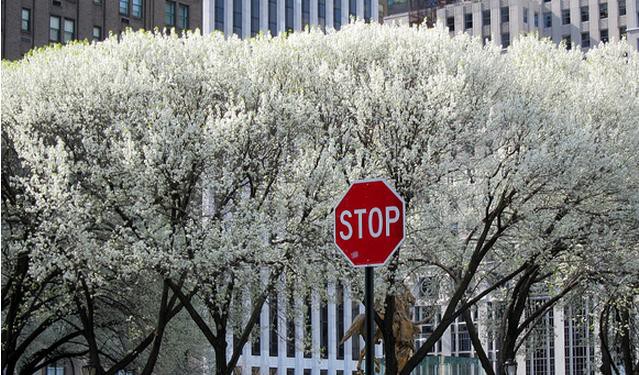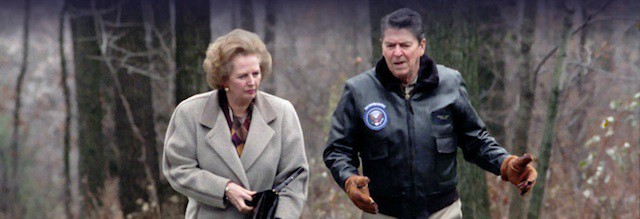Snooty Highbrow Culture, Yessiree!
Eggheads will be rewarded tonight by Diller, Scofidio and Renfro at the NYPL, or the big gay meet-up of Andrew Solomon and Tony Kushner at the Strand. And more.
Your Street Probably Smells Like Semen Right Now -- But It Might Not Next Spring
by Juliet Lapidos

On a mild April night some years ago, I walked past a college dorm in New Haven and smelled something I couldn’t place. It reminded me vaguely of swimming pools. Was it chlorine? I sniffed again, more deeply than before. Suddenly I knew exactly what it was and hurried away, internally berating an unseen teenage boy. A few evenings later, in the same spot, I smelled it again. Filled with a sense of moral outrage I looked around, I looked up, and identified the culprit: A tree.
More precisely, a Callery Pear, or Pyrus calleryana, a deciduous tree that’s common throughout North America. It blossoms in early spring and produces beautiful, five-petaled white flowers — that smell like semen.
Like when you learn a new word and then see and hear it everywhere, after making the connection between Callerys and the scent of semen I saw and smelled them everywhere. I said that Callerys are “common”: A preposterous understatement. In Manual of Woody Landscape Plants, which is for horticulturists what the DSM is for psychotherapists, Michael Dirr says that the Bradford Pear — a Callery cultivar — inhabits “almost every city and town to some degree or another” and warns that “the tree has reached epidemic proportions.” There’s one between my apartment and my favorite coffee shop in Brooklyn, and there’s probably one between your apartment and your favorite coffee shop. The last time New York’s Parks Department conducted a tree census, from 2005 to 2006, there were 63,600 Callery Pears, making it the third-most popular species in the city, after the London Planetree and the Norway Maple.
The Callery’s aroma is an open secret. Three years ago The Frisky published an article titled “A Tree That Smells Like…Well…Um…,” which directed me to a Yahoo! Answers thread on the topic, and to the Urban Dictionary entry “Semen Tree.”
But in the professional literature, euphemisms abound. Dirr calls the Bradford “malodorous” and leaves it at that. (By contrast, here’s how he describes the Bradford’s fall coloration: “spectacular reddish purple, others yellow to red reminding of a persimmon orange.”)
The way I see it, there’s weirdly little attention paid to the fact that, for a few weeks each year, there’s a good chance your street smells like semen. We just carry on as if that were normal.
The Callery’s not even the most-talked-about smelly tree, a distinction that certainly belongs to the vomit-perfumed Ginkgo. There’s even a New Yorker Talk of the Town about the Ginkgo’s stench — and the three media-savvy teenagers who formed an Anti-Gingko Tolerance Group. But the Callery? The New Yorker doesn’t care. There is no Anti-Callery Tolerance Group.
Despite the absence of grassroots agitating against the Callery, we may have reached peak semen-smell. As Dirr puts it, Bradfords tend to “develop rather tight crotches,” which makes them prone to splitting as they age. And while not every Callery cultivar splits easily — the Aristocrat and the Chanticleer fare better — they’re all borderline invasive, taking up shop in abandoned lots without human intervention. (And less urban ecosystems as well: A National Parks Service publication explains how to cut them down and apply herbicides to the stumps.) For these reasons — not because of their smell — they’re falling out of vogue with urban parks departments.
New York now plants just 20 or 30 Callerys per year, while literally thousands are lost to attrition (from storm damage and such). Jeremy Barrick, the deputy chief of forestry, horticulture and natural resources at the Parks Department, expects the Callery to lose its number 3 spot in the 2015 census. He anticipates a total Callery count of roughly 30,000 — a 50-percent decline from 2006.
That’s progress. But for the time being, you can tell it’s spring if you smell semen.
Juliet Lapidos is an editor at the New York Times. Photo by Bosc d’Anjou.
New York City, April 8, 2013

★★★★★ Sparrows were singing from the traffic lights, perched on the tubular cross-braces atop the posts. A morning glow filled the street; two daffodils were up in the beds behind the scaffolding. A man on the train was wearing flip-flops, though there were still puffy jackets on the platform. The bodega flowers smelled like flowers. A sunbeam fell on a red bicycle. In the treetops, buds were opening, a tentative tan. Men wore suits easily, without coats; other men, on the same sidewalks, carried skateboards pointing up and down.
Frightening Man To Use Wealth To "Target" Women On Internet!

A “serial entrepreneur” is in “stealth mode” for his “new blog” which, he reveals, is going to “target female readers,” because “so much of the new media publishing focus is still on men” and “there is a massive market failure going on right now” and “so few new media properties have tried to capture the demographic .” No, I’ve actually cherry-picked the good sentences
I know, it’s so crazy, absolutely no one has touched the market for women online, now maybe finally someone will build a web publishing company that “targets female readers” and then take it public, because what an amaaaaazingly good idea that would be. Blogs! With publicly traded stock! A magnificent vision.
Watch A Navy Boat Blast An Airplane Out Of The Sky With A Laser Beam
8-year-old me would have been VERY DISAPPOINTED to learn that when finally we weaponized laser beams in real life they’d be invisible instead of glowing green or orange or purple like they’re supposed to. Can’t the Navy just add some food coloring or something? Also, I can’t believe they put this video up without a soundtrack
. Come on, man! If there has ever been an opportunity for the United States government to officially crank “Tom Sawyer” it is this! (Also acceptable: Lil Scrappy’s “Problems.” But that is all. Those are the best two laser beam sounds ever recorded.) [Via]
Skin Cancer Survivors Still Enjoy Tanning Beds

Researchers cannot even believe what they’re hearing from melanoma survivors these days, because a shocking 27.7% of survivors of the horrible skin cancer still aren’t wearing sunscreen when they’re out in the sun. But the ultimate thrill seekers are the 2% of melanoma survivors who continue to use tanning beds. There is something kind of fantastic about a melanoma patient paying money to a tanning salon — it’s like those old dudes who smoke through the hole in their throat.
“That blew my mind,” study author Dr. Anees Chagpar of Yale University told the Los Angeles Times. We hope he writes his science research papers like that, too.
Photo by MSPhotographic.
Blue Angels Air Shows, the Only Live Theater Real Americans Love, Shut Down By Sequester

There’s nothing like going out to some sun-blasted airfield an hour outside of town to see the famous Blue Angels fly around so close to each other that you never know when they’ll crash into the spectators — it’s the perfect mix of NASCAR and military worship, and Republicans in Congress have shut down this beloved display of air superiority.
“The Navy believes there is value in demonstrating the professionalism and capabilities of our Navy and Marine Corps Naval Aviation team, thus inspiring future generations of Sailors and Marines,” the Blue Angels said in a love letter to Obama press release. “The Navy intends to continue aerial demonstrations in the future as the budget situation permits.”
Reagan Library Just Happened To Have a Thatcher Exhibition Ready For Today

“The alliance between Margaret Thatcher and Ronald Reagan was one of the most enduring political friendships of the past 50 years. The former British prime minister and the decades-long relationship between the two families is the subject of a new exhibition that the Reagan Library and Museum will present starting Tuesday at its location in Simi Valley.”
— If you hooligans are done having “street parties” and smashing windows in the U.K., and if you’re done tramping the dirt down in Africa, and all these other rude displays, perhaps it’s time to seek forgiveness at the Ronald Reagan Presidential Library’s thrown-together salute to Margaret Thatcher, which opens today about a month’s drive from Los Angeles in exurban Simi Valley. (Thatcher loathed Reagan, too.)
Photo via the Reagan Library.
Life So Awful Now People Pine For The Era Of Billy Squier, Joysticks, 'Scarecrow And Mrs. King'
“Despite its reputation for bad hair and loud clothing, just about everything about the era — from the politics, leaders and safety to the music, TV shows and blockbuster movies — are seen as being better than they are today. In fact, 3 in 4 Americans (74%) thought that our country was better off then and even safer (76%). The same amount (76%) believe that government ran better in the 1980s than it does today. And if a presidential election were held today, 58 percent would vote for Ronald Reagan over Barack Obama. Americans ages 18 to 34 were evenly split, with 51 percent favoring Reagan and 49 percent Obama. At least 4 in 10 Americans believe that movies (42%), TV shows (52%) and music (71%) were better in the ’80s than they are now. And nearly two-thirds (65%) of adults 18 to 34 and a whopping 88 percent of recent college grads who responded to the survey and didn’t live through the ’80s said that they wished they had been around for the tubular times!”
Andy Johns, 1950-2013
“In the early 1970s, Johns was involved at different times with both Led Zeppelin and the Rolling Stones. While the guitarist Jimmy Page had general supervision of Led Zeppelin recordings, Johns was often on hand to provide creative solutions or improvements to the sound. The most renowned example was a drum sound achieved at the Headley Grange studio in Hampshire in 1971. One of Bonham’s drum kits was set up in the hallway of the Grange. Johns carefully lowered a pair of microphones over the banister of the staircase above and captured the sound which formed the basis of the song When the Levee Breaks on the group’s fourth album. It has become one of the most emulated drum sequences in rock music.”
— Sound engineer Andy Johns was 62.
